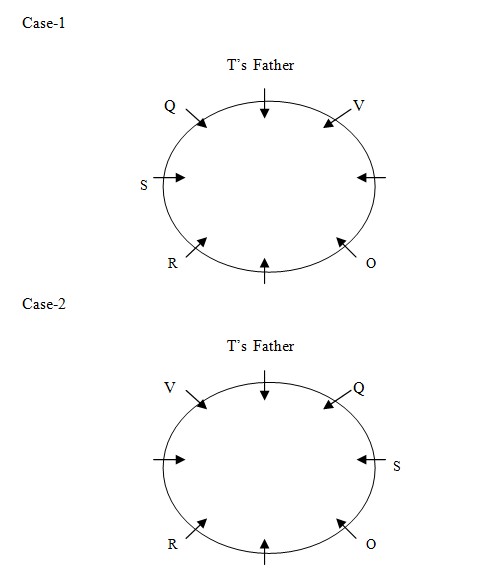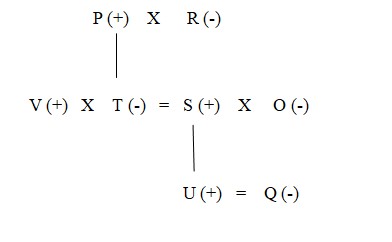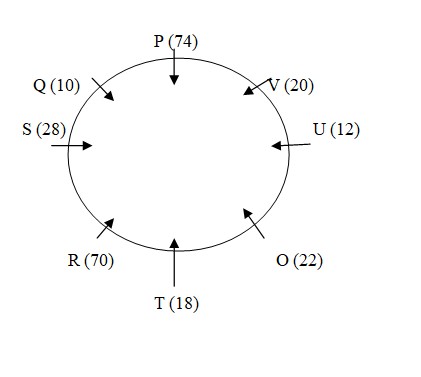Question
How many persons are older than S?
Study the following information carefully and answer the question below- There is a family of eight people O, P, Q, R, S, T, U and V and are sitting around a circular table facing to the centre. There are three married couples in the family. They are from three generations. None of the member of the third generation is married. They are of different age but their ages are in descending order according to their generation such as Grandfather is the eldest, grandmother is the second eldest, son is the third eldest, daughter- in – law is the fourth eldest, son – in – law is the fifth eldest, daughter is the sixth eldest, grandson is the seventh eldest and granddaughter is the eighth eldest. The person who sits immediate right of V is a male but he is not U. S who is sitting next to Q is not sitting opposite to O. Only the father of T is sitting between Q and V. Q is the female member of the family. V’s age is 2 year less than O’s age and O’s age is 6 year less than S’s age. U’s age is multiple of 4 but not a perfect square. R is the mother of S and her age is 2.5 of the age of her son. R is 4 year younger than P. The age of the second eldest person is 70 year. V is the brother – in – law of O. P does not sit opposite to the second youngest person. T does not belong to third generation. T has no child. The person who is sitting on the immediate left of O and immediate right of R is 18 years old while Q is 10 year old.Solution
The age of the second eldest person is 70 year which means the age of the grandmother is 70 year. V is the brother – in- law of O. V’s age is 2 year less than O’s age and O’s age is 6 year less than S’s age. R is the mother of S and her age is 2.5 of the age of her son. From these it is clear that O, V and S belongs to second generation and R is the grandmother whose age is 70 year. Further, only the father of T is sitting between Q and V. T does not belong to third generation. So, T belongs to second generation. The person who is sitting on the immediate left of O and immediate right of R is 18 year old while Q is 10 year old. S, who is sitting next to Q, is not sitting opposite to O.  Q is the female member of the family. Q is 10 year old. So, Q is the granddaughter and 10 year old. R is 4 year younger than P. Means P is 74 year old. Rest U’s age is multiple of 4 but not a perfect square. As only remaining position is that U is the grandson and is 12 year old. The person who sits immediate right of V is a male but he is not U. So, from this case 3 will be eliminated. As we know that U can’t sit between R and O, so clearly T sit between R and O and U can’t sit to immediate right of Q so from this case 2 will be eliminated. Rest we know that the age of T is 18 year so she is the daughter of P and S is the son of R and is 28 year old. Rest V is 20 year old, O is 22 year old, O is 22 year old. So, the final arrangement is –
Q is the female member of the family. Q is 10 year old. So, Q is the granddaughter and 10 year old. R is 4 year younger than P. Means P is 74 year old. Rest U’s age is multiple of 4 but not a perfect square. As only remaining position is that U is the grandson and is 12 year old. The person who sits immediate right of V is a male but he is not U. So, from this case 3 will be eliminated. As we know that U can’t sit between R and O, so clearly T sit between R and O and U can’t sit to immediate right of Q so from this case 2 will be eliminated. Rest we know that the age of T is 18 year so she is the daughter of P and S is the son of R and is 28 year old. Rest V is 20 year old, O is 22 year old, O is 22 year old. So, the final arrangement is – 

The opening on an arthropod body surface that allows for air transfer is called:
Which one of the following buffalo breed is the highest milk yielder?
Which test is used when sample size is large (>30) and population standard deviation is known?
Which among the following is not asexual spore of fungi?
Which of the following is not a cause of seed deterioration?
What does opportunity cost in farming refer to?
Which of the following is known as fertilizer tree?
Extension Programme is a statement of situation, objectives, problems and:
Which of the following statement is/are correct?
A. India’s first National Water Policy was adopted in 1977.
B. Most of the water in vap...
Floor space required for a cow in a covered space in sq. feet?
Relevant for Exams:


